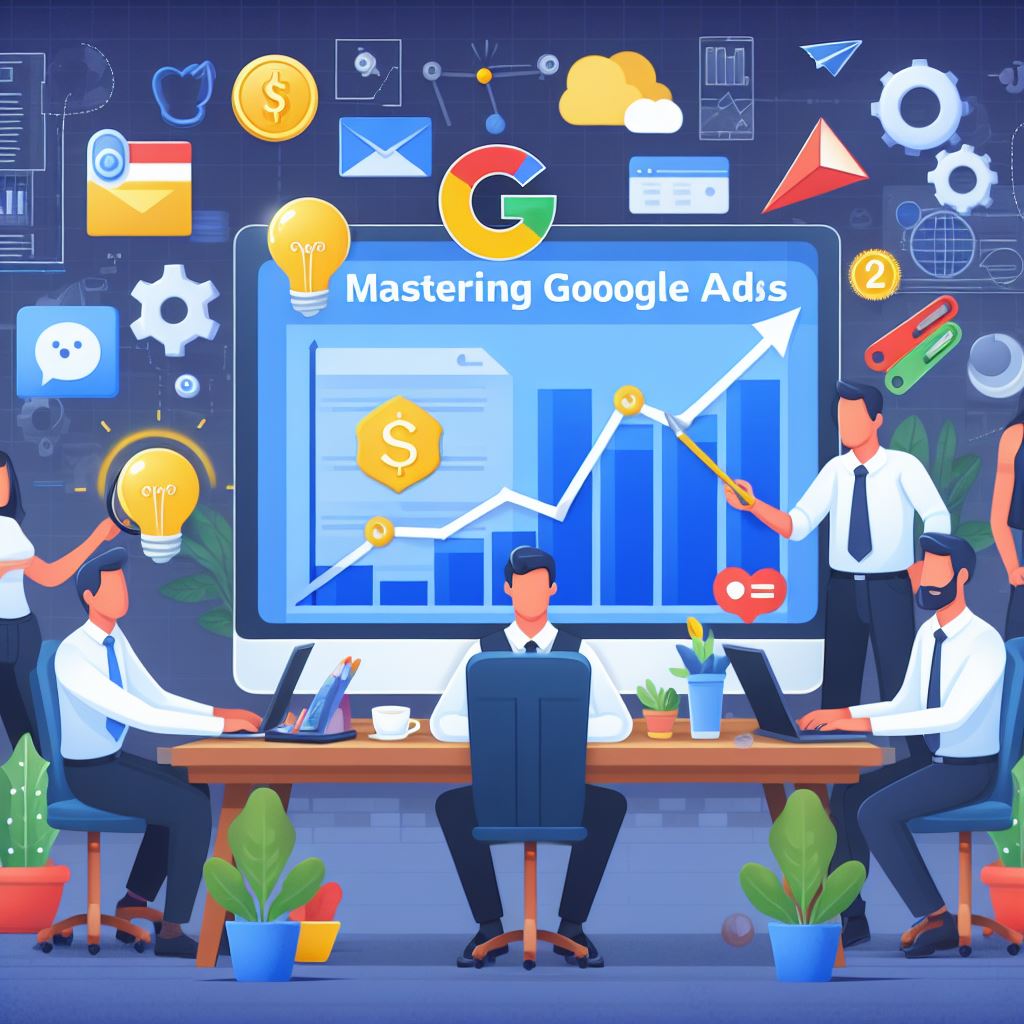Mastering Google Ads: “Boost Your Business with Effective Campaigns”
Introduction: Mastering Google Ads for Business Growth

Welcome to the world of Google Ads, where strategic advertising meets limitless potential for business growth. In today’s digital age, the ability to leverage online advertising platforms effectively is paramount to achieving marketing success and expanding your business’s reach. This comprehensive guide is designed to empower you with the knowledge and skills needed to craft compelling Google Ads campaigns that drive tangible results and propel your business forward.
- The Digital Advertising Landscape
The digital advertising landscape has undergone a profound transformation, with Google Ads emerging as a powerhouse platform for businesses of all sizes. With billions of daily searches conducted on Google, the platform offers unparalleled access to a vast audience actively seeking products, services, and information. Google Ads provides a versatile toolkit for advertisers, allowing them to target specific audiences, showcase their offerings, and measure campaign performance with precision.
- Why Master Google Ads?

Mastering Google Ads isn’t just about running ads; it’s about unlocking the full potential of digital advertising to fuel business growth. Whether you’re looking to increase website traffic, generate leads, boost sales, or enhance brand visibility, Google Ads offers a myriad of opportunities to achieve your marketing objectives. By harnessing the power of Google’s robust ad platform, you can reach potential customers at every stage of their buyer’s journey, from initial awareness to conversion and beyond.
- Empowering Business Growth
Effective Google Ads campaigns can be transformative for businesses, offering a scalable and cost-effective way to connect with your target audience, drive qualified traffic, and maximize your return on investment (ROI). Whether you’re a small startup or an established enterprise, the ability to craft compelling ads, optimize campaign performance, and leverage data-driven insights can make a significant impact on your bottom line.
- What to Expect
In this guide, we’ll take a deep dive into the key elements of successful Google Ads campaigns. You’ll learn how to conduct keyword research to identify profitable keywords, create persuasive ad copy that resonates with your audience, leverage advanced targeting options to reach the right users, design visually engaging ads, and optimize campaigns for maximum effectiveness. Each section will equip you with actionable strategies, best practices, and practical tips to elevate your Google Ads game and drive sustainable business growth.
- Let’s Get Started
Whether you’re new to Google Ads or looking to refine your existing campaigns, this guide is your roadmap to success in the ever-evolving digital advertising landscape. Get ready to unlock the full potential of Google Ads and propel your business to new heights of success!
1.Understanding Google Ads
Introduction: Google Ads, formerly known as Google AdWords, is Google’s online advertising platform that allows businesses to create and run ads on Google’s search engine and display network. Understanding how Google Ads work is essential for leveraging its full potential for business growth.
What are Google Ads and how do they work? Google Ads are online advertisements displayed on Google’s search engine results pages (SERPs) and other partner websites. They operate on a pay-per-click (PPC) model, where advertisers bid on keywords relevant to their target audience. When users search for these keywords, Google displays relevant ads, and advertisers pay only when their ad is clicked.
Benefits of using Google Ads for business growth:
Targeted reach: Reach users actively searching for products or services related to your business.
Cost-effective: Pay only when someone clicks on your ad, making it budget-friendly.
Measurable results: Track and analyze ad performance metrics to optimize campaigns.
Flexible budgeting: Set your budget and adjust bids based on performance and objectives.
Introduction to Google Ad Maker and Google Ads Keyword Planner Tool: Google Ad Maker is a tool that helps create visually appealing ads with customizable templates and elements. The Google Ads Keyword Planner Tool is invaluable for keyword research, providing insights into keyword volume, competition, and potential bid estimates.
2.Setting Up Your Google Ads Account
Introduction: Before diving into creating ads, you need to set up a Google Ads account. This section will guide you through the process of creating an account and navigating the Google Ads dashboard.
Step-by-step guide to creating a Google Ads account:
Visit the Google Ads website: Go to the Google Ads website and click on “Start Now.”
Enter business information: Provide your business information, including website URL, business type, and location.
Set budget and goals: Set your budget, select campaign goals, and choose your target audience.
Create ad groups: Create ad groups and select keywords relevant to your business.
Navigating the Google Ads dashboard for campaign setup: The Google Ads dashboard is where you manage your campaigns, ad groups, keywords, and ad performance. Familiarize yourself with the dashboard layout and navigation menus to set up and monitor your campaigns effectively.
Understanding campaign objectives and ad formats: Google Ads offers various campaign objectives based on your business goals, such as website traffic, leads, sales, or brand awareness. Choose the objective that aligns with your business objectives. Additionally, familiarize yourself with different ad formats, including text ads, image ads, video ads, and responsive ads, to create compelling and engaging ads.
3.Conducting Keyword Research
Importance of Keyword Research in Google Ads Campaigns: Keyword research is the backbone of successful Google Ads campaigns. It involves identifying and selecting relevant keywords that potential customers are likely to use when searching for products or services similar to yours. The importance of keyword research lies in:
Relevance: Targeting relevant keywords ensures that your ads are shown to users actively searching for what you offer, increasing the chances of conversions.
Cost-effectiveness: Well-researched keywords help optimize ad spend by targeting specific audiences interested in your offerings, reducing wasted clicks and maximizing ROI.
Optimization: Continuously updating and optimizing your keyword list based on performance data helps improve campaign effectiveness over time.
Utilizing Google Ads Keyword Planner Tool for Keyword Discovery: The Google Ads Keyword Planner Tool is a powerful resource for discovering new keywords and gathering valuable insights. Here’s how to effectively use the tool:
Keyword Ideas: Enter seed keywords related to your business, products, or services to generate keyword ideas. Review the suggested keywords, their search volume, competition level, and estimated bid amounts.
Keyword Trends: Analyze keyword trends over time to identify seasonal or trending keywords that can be incorporated into your campaigns for timely targeting.
Keyword Grouping: Group relevant keywords into ad groups based on themes or topics to create targeted and organized campaigns.
Negative Keywords: Identify and add negative keywords to your campaigns to prevent your ads from showing for irrelevant searches, thereby improving ad targeting and reducing costs.
Tips for Finding High-Performing Keywords for Your Ads:
Long-Tail Keywords: Target long-tail keywords that are more specific and have lower competition, often leading to higher conversion rates.
Competitor Analysis: Analyze competitors’ keywords to identify opportunities and refine your own keyword strategy.
Localized Keywords: Incorporate location-based keywords if your business targets specific geographic regions.
Keyword Match Types: Use different keyword match types (broad match, phrase match, exact match, and broad match modifier) strategically to control ad targeting and match user intent effectively.
4.Crafting Compelling Ad Copy

Best Practices for Writing Effective Ad Copy: Compelling ad copy is crucial for capturing users’ attention and driving them to take action. Follow these best practices:
Clear and Concise Messaging: Clearly communicate your value proposition and key benefits in a concise manner.
Compelling Call-to-Action (CTA): Include a strong and actionable CTA that encourages users to click on your ad, such as “Shop Now,” “Learn More,” or “Get Started.”
Highlight Unique Selling Points (USPs): Showcase what sets your business apart from competitors, such as special offers, free shipping, or unique features.
Use Keywords Strategically: Incorporate relevant keywords into your ad copy to improve ad relevance and quality score.
Address Pain Points: Identify and address potential customers’ pain points or challenges, offering solutions through your products or services.
Using Ad Extensions to Enhance Ads’ Visibility and Engagement: Ad extensions are additional pieces of information that expand your ad and provide more context to users. Utilize various ad extensions such as:
Sitelink Extensions: Direct users to specific pages on your website, such as product pages, services, or promotions.
Callout Extensions: Highlight key benefits, promotions, or unique selling points directly in your ad.
Call Extensions: Enable users to call your business directly from the ad, increasing engagement and conversions.
Structured Snippets: Showcase additional information about your business, such as product categories, services offered, or features.
A/B Testing Ad Variations for Optimal Performance: A/B testing, also known as split testing, involves creating multiple ad variations with different elements (headline, ad copy, CTA, etc.) and testing them to determine which performs better. Here’s how to conduct A/B testing effectively:
Identify Variables: Decide which elements you want to test, such as headline variations, ad copy, CTA text, or ad extensions.
Create Variations: Develop multiple ad variations with distinct elements for each variable you’re testing.
Run Experiments: Run the ads simultaneously to gather data on their performance, including click-through rates (CTRs), conversion rates, and cost-per-conversion.
Analyze Results: Analyze the performance data to identify winning variations and make data-driven decisions to optimize your ad campaigns.
5.Designing Eye-Catching Visuals
Importance of Visual Elements in Google Ads: Visual elements play a crucial role in Google Ads by capturing users’ attention, conveying your brand message, and driving engagement. Here’s why they are important:
Attention-Grabbing: Visuals such as images and videos can grab users’ attention more effectively than text-only ads, increasing ad visibility and click-through rates.
Brand Identity: Visuals help reinforce your brand identity and create a memorable impression among users, fostering brand recognition and loyalty.
Emotional Impact: High-quality and relevant visuals can evoke emotions, resonate with users, and persuade them to take desired actions, such as making a purchase or signing up.
Enhanced Communication: Visuals can communicate complex information or product features more effectively than text, making your ads more engaging and compelling.
Tips for Creating Engaging Ad Visuals:
High-Quality Images and Videos: Use high-resolution images and videos that are clear, visually appealing, and relevant to your ad message.
Consistent Branding: Maintain consistent branding elements such as colors, fonts, and style across your ad visuals to reinforce brand identity.
Relevance: Ensure that your visuals align with your ad copy and target audience’s interests and preferences for maximum impact.
Clear Call-to-Action (CTA): Include a clear and actionable CTA in your visual elements to prompt users to take the desired action, such as “Shop Now,” “Learn More,” or “Sign Up.”
Visual Hierarchy: Arrange visual elements in a strategic hierarchy to guide users’ attention and emphasize key messages or offers.
Incorporating Multimedia Elements Like Images and Videos for Impact:
Images: Use compelling product images, lifestyle photos, or infographics that showcase your offerings and highlight key benefits or features.
Videos: Create engaging and informative videos that demonstrate your products or services, tell a story, or provide valuable insights to viewers.
Carousel Ads: Utilize carousel ads to showcase multiple visuals or products within a single ad, allowing users to swipe through and explore offerings.
6.Tracking Ad Performance Metrics and Interpreting Data:

Ad Performance Metrics:
Click-Through Rate (CTR): Measures the percentage of users who click on your ad after seeing it. A higher CTR indicates that your ad is relevant and engaging to users.
Conversion Rate: Tracks the percentage of users who complete a desired action (e.g., making a purchase, signing up) after clicking on your ad. It reflects the effectiveness of your ad in driving conversions.
Cost Per Acquisition (CPA): Calculates the average cost incurred to acquire a new customer or lead through your ad campaigns. Lower CPA indicates efficient campaign management.
Quality Score: Google Ads’ metric that evaluates the relevance and quality of your ads, keywords, and landing pages. Higher Quality Scores result in lower costs and better ad positions.
Impressions and Reach: Measures how many times your ad is displayed (impressions) and the unique number of users who see it (reach). It indicates your ad’s visibility and potential audience reach.
Interpreting Data:
Analyze trends and patterns in ad performance metrics over time.
Identify top-performing ads, keywords, targeting options, and campaigns.
Evaluate conversion paths and user journeys to understand the effectiveness of your ad funnel.
Monitor budget allocation and spending to ensure optimal resource utilization.
Compare performance against industry benchmarks and competitor insights.
Making Data-Driven Optimization Decisions to Improve Campaign Performance:
Optimization Strategies:
Keyword Optimization: Refine keyword targeting based on performance data, focusing on high-converting keywords and eliminating low-performing ones.
Ad Copy Optimization: Test and optimize ad copy elements such as headlines, descriptions, CTAs, and offers to improve CTR and conversion rates.
Bid Management: Adjust bids based on keyword performance, ad positions, and budget constraints to maximize ROI and ad visibility.
Audience Targeting: Refine audience segments, demographics, interests, and behaviors based on data insights to reach the most responsive audiences.
Device Optimization: Optimize ad campaigns for different devices (desktops, mobile, tablets) based on performance metrics and user behavior patterns.
Ad Extensions: Utilize ad extensions (e.g., site links, callouts, structured snippets) to enhance ad visibility, provide additional information, and encourage user engagement.
Best Practices for Continuous Campaign Optimization and Refinement:
Continuous Monitoring: Regularly monitor ad performance metrics, trends, and changes to identify optimization opportunities and challenges.
A/B Testing: Conduct A/B tests to compare different ad variations, landing pages, targeting options, and bidding strategies to identify winning combinations.
Keyword Expansion: Continuously expand and refine your keyword list based on search trends, user queries, and competitor analysis to capture new opportunities.
Ad Creative Refresh: Regularly update ad creatives, visuals, messaging, and offers to prevent ad fatigue and maintain audience engagement.
Performance Reviews: Conduct periodic performance reviews, audits, and optimizations based on data-driven insights and actionable recommendations.
By implementing these strategies and best practices, you can effectively optimize your Google Ads campaigns, improve performance metrics, and achieve your campaign goals more efficiently.
7.Conclusion: Mastering Google Ads for Business Growth
Congratulations on completing this comprehensive guide to mastering Google Ads for business growth! You’ve delved into the intricacies of keyword research, ad copy creation, audience targeting, visual design, and campaign optimization. Let’s recap the key takeaways and the broader implications of this knowledge:
Strategic Approach: You’ve learned the importance of a strategic approach to Google Ads, starting from conducting thorough keyword research to identify high-performing keywords that align with your business objectives. This strategic foundation ensures that your ads reach the right audience at the right time, maximizing your campaign’s effectiveness.
Compelling Ad Copy: Crafting compelling ad copy is essential to capture users’ attention and encourage them to take action. You’ve explored best practices for writing engaging ad copy, leveraging ad extensions, and conducting A/B testing to optimize ad performance and drive conversions.
Audience Targeting: Understanding your target audience and utilizing Google Ads’ advanced targeting options are pivotal for delivering relevant ads to the right audience segments. Tailoring your ads based on audience demographics, interests, behaviors, and intent ensures higher engagement and conversion rates.
Visual Design: The visual appeal of your ads plays a significant role in attracting users’ attention and conveying your brand message effectively. You’ve gained insights into creating eye-catching visuals, incorporating multimedia elements like images and videos, and enhancing ad visibility and engagement.
Data-Driven Optimization: Data-driven optimization is the cornerstone of successful Google Ads campaigns. By tracking ad performance metrics, interpreting data insights, and making informed optimization decisions, you can continuously refine your campaigns, improve ROI, and achieve your business goals.
Continuous Improvement: The journey to mastering Google Ads doesn’t end here. It’s a continuous process of experimentation, analysis, and optimization. Keep refining your keyword strategy, ad creatives, targeting settings, and bidding strategies to stay competitive and drive sustained business growth.
By implementing the strategies and techniques outlined in this guide, you’re well-equipped to navigate the dynamic landscape of Google Ads, drive meaningful results for your business, and stay ahead of the competition.
Would you like to dive deeper into any specific aspect or explore additional topics related to Google Ads and digital advertising? Let’s continue this journey of learning and growth together!
